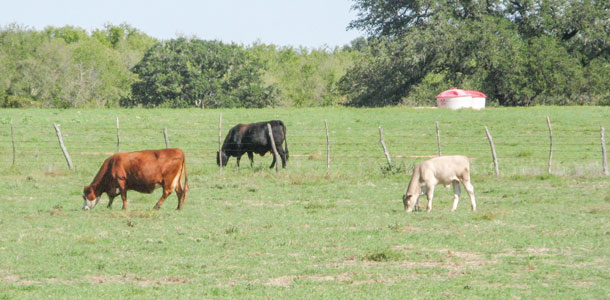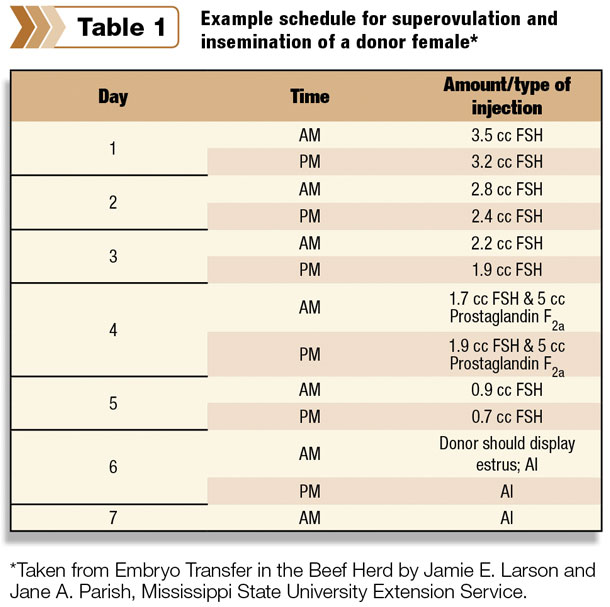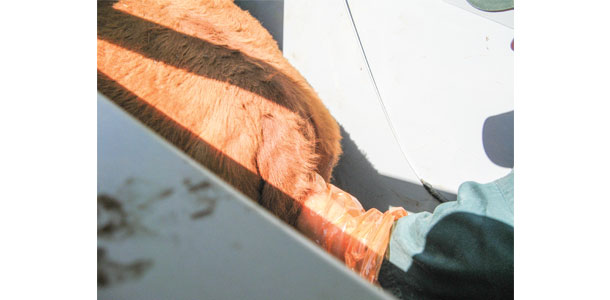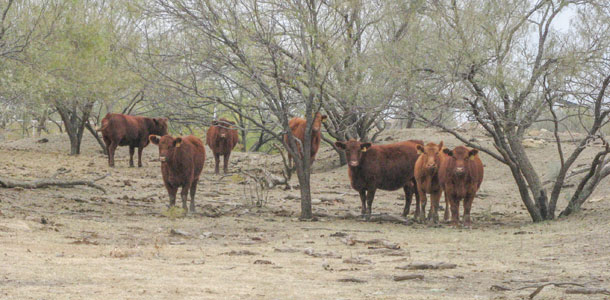The entire process involves breeding a donor cow (usually by A.I.), flushing embryos from the donor and injecting embryos into recipient cows.
“ET has recently gained considerable popularity with seedstock dairy and beef producers,” says Tom Troxel, University of Arkansas Division of Agriculture Research and Extension. “Most of the applicable embryo transfer technology was developed in the 1970s and 1980s; however, the history of the concept goes back much farther.
Initially, embryos were recovered from valuable donors and transferred to recipient animals using surgical procedures. It was not until non-surgical methods were developed in the late 1970s that embryo transfer grew in popularity.”
In presentations at various breed association seminars, Craig Barton of Champion Genetics talks about the ABCs of successful embryo transfers, which are:
A Overcome challenges to success
B Flush embryos, not money
C Help improve pregnancy rates
Each of these requirements is discussed in the following paragraphs.
Overcome challenges to success
The first challenge in ET is selection of the right donor. “Female donors should be of superior genetic worth and marketability to justify ET costs,” says Jamie Larson of Mississippi State University. “Mating decisions should be made considering the genetic worth and economic value of potential calves. The reproductive potential of a donor female must also be acceptable.
“An ideal donor female has had regular estrous (heat) cycles beginning at a young age, routinely conceives with no more than two inseminations, maintains a 365-day- or-less calving interval, calves without difficulty, is free of reproductive abnormalities and disease, and has no conformational or known genetic defects,” Larson continues.
“Good nutritional management of these females is critical for productivity as embryo donors. This involves managing body condition and providing proper nutrients, including minerals, important to reproductive function.”
“Egg production in a cow is on a bell curve by age,” Barton says. “Heifers are on one tail of the curve and older cows on the other; therefore, the middle-aged cows at the top of the curve produce the most eggs. One of the reasons young females are not recommended for ET is that flushing virgin heifers is very stressful on their ovaries.
“Good egg producers can be identified by an AMH (Anti Mullerian Hormone) test which has been shown to indicate the amount of ovarian follicular reserve. Females with low levels of AMH respond poorly to reproductive treatments.”
“To maximize embryo survival in the recipient female following transfer, conditions in the recipient reproductive tract should closely resemble those in the donor,” Troxel says. “This requires synchronization of the estrous cycles between the donor and the recipients, optimally within one day of each other.”

Superovulation of the donor cow is a challenge to success because the process steps require exact timing and cattle have to be handled twice daily.
“Superovulation is the release of multiple eggs at a single estrus,” Troxel explains. “Cows properly treated can release as many as 10 or more viable eggs at one estrus. Approximately 85 percent of all normal fertile donors will respond to superovulation treatment with an average of five transferable embryos.”
The basic principle of superovulation is to stimulate extensive follicular development through the use of follicle-stimulating hormone (FSH). According to Wikipedia, follicles are the basic units of female reproductive biology, composed of cell aggregations in the ovary. Follicles contain a single oocyte (immature ovum or egg).
Combinations of hormones are administered over several days to stimulate superovulation. In addition to FSH, Prostaglandin F2a is used to allow the cow to come into estrus. Embryo transfer technicians often have their own preferred protocol, but an example is depicted in Table 1.

“Begin the ET process with a donor that is open and at least 60 days post-calving,” Barton says. “Superovulate the donor, bring her into heat and breed her with three straws of semen as indicated in Table 1. Flush out the embryos seven days post-breeding.”
Flushing embryos, not money
Flushing embryos, not money, requires selection of the right donor and a proper procedure conducted by a skilled technician.
“The donor’s body condition score should be no less than 4, and she should have been vaccinated for the prevalent diseases such as blackleg, IBR (Infectious Bovine Rhinotracheitis), lepto (Leptospirosis) and BVD (Bovine Viral Diarrhea),” Barton says. “Multimin 90, a supplemental source of zinc, manganese, selenium and copper, is recommended as well as Vitamin A, D and E. In addition, they should be on a good reproduction mineral program.”

“To collect embryos non-surgically, a small synthetic rubber catheter is inserted through the cervix (opening into the uterus) of the donor cow and a special medium is flushed into and out of the uterus to collect the embryos,” Troxel explains. “This is done seven days after estrus. The collection procedure is relatively simple and can be completed in 30 minutes or less without harm to the cow.”
“Flushing media is allowed to flow into the uterine body, where the technician massages the uterus to allow the fluid to pick up any embryos present,” Larson states. “The fluid is then allowed to flow out of the uterus and through a very fine filter that traps the embryos. This process is repeated many times by the technician, sometimes focusing on one uterine horn and then the other.
“The filter used to capture the embryos is rinsed to collect them in a dish. This dish is placed under a microscope so the technician can locate and retrieve each individual embryo. Once all embryos are found, they each receive a two-number classification according to developmental stage and quality grade."
"After classification, embryos are ready to be transferred or frozen for later use. Around eight transferable or six freezable embryos per flush can be expected, on average. However, some females will produce fewer embryos, and others can produce 30 or more quality embryos in one flush.”
Help improve pregnancy rates
“When embryos are to be transferred fresh, they are loaded directly into 0.25 cc (cubic centimeter) plastic straws and transferred using a rod similar to an A.I. rod,” Larsen continues. “Most A.I. rods are designed to use 0.5 cc, but those used to inseminate with sex-sorted semen are designed for 0.25 cc straws.
“To thaw frozen embryos, the straw should be removed carefully from the tank, held in the air for 10 seconds and then placed in a water bath between 77 and 86 degrees Fahrenheit, which is cooler than the temperature used to thaw semen."

"The straw should remain in the water bath until all ice has melted, approximately 30 seconds. The cap is removed from the straw and loaded into the transfer rod, and then a transfer sheath is placed over it. The rod is passed through the cervix, and the embryo is deposited in the uterine horn on the same side that ovulation occurred.”
“It is as important to choose the right recipient cows as it is to select the appropriate donor,” Barton says. “Desired qualities of the recipient females are very similar to those required of the donor."
"Recipients should be mature cows, 3 to 6 years old and not nursing a calf. The cows should exhibit good temperament and have good body condition scores. They should be in good health and free of disease, including Johnes and leucosis. Donors should be wormed and vaccinated as recommended by the local veterinarian.”
Barton says that odds of lower pregnancy rates will occur if the following decisions are made:
- I want to use fewer straws of semen. It’s really expensive and I only have one.
- I want to use sexed semen. (Fertilization rate with sexed semen will likely be decreased.)
- My cow hasn’t bred in a couple of years, so I want to use her as a donor.
- I just bought my recipients at the sale barn.
- My recipients are the ones that didn’t calve this year.
Proper execution of each step in the ET process is critical and adhering to the ABCs of embryo transfers provides a pathway to success. ![]()
Robert Fears is a freelance writer based in Texas.
PHOTOS
PHOTO 1: Desired qualities of the recipient females are very similar to those required of the donor.
PHOTO 2: The embryo transfer process should begin with a donor that is open and at least 60 days post-calving.
PHOTO 3: A numbing agent is injected into the spinal cord, near the tailhead, to eliminate muscular contractions and allow the technician to more easily manipulate the uterus and flushing tubing in the reproductive tract.
PHOTO 4: Young females are not recommended for embryo transfers because flushing virgin heifers is very stressful on the ovaries. Photo courtesy by Robert Fears.








